This week we celebrate Spring with sufficient lead time to change some of your tackle to lead-free options for fresh and saltwater fishing. Lead is commonly used to sink baits and lures but there are a host of negatives to lost lead in ponds and rivers. Glasswater Angling has a line of tackle alternatives built to help you catch fish without damaging those waters we love. And the owner is a total character.

John King finds fish without lead
Lead is dense so small amounts help you pound some sand to attract fluke with squid strips or call to stripers with clam tongues and bank sinkers or even weigh down largemouth spinners. Lead is also easy to melt, lending itself to a variety of shapes. And it’s not expensive. A 12.5 pound pure lead ingot costs about $40. Alternative materials are available but are more costly and not as easy to manipulate. Truth is, lead is poisonous. It degrades in water, especially acidic waters, which leads to the poisoning of birds and fish, many of which we might later harvest and eat.
Glasswater Angling Lead-Free Lures are a beginning to a solution
Enter John King, aka John “Crappy Hippy” King, and his Glasswater Angling company. From their home office in Edgerton, Kansas. John and his wife Kathy design and sell lead-free fishing lures and jigs. The goal of Glasswater Angling Lead-Free Lures is to produce top quality tackle for a variety of situations and locations with materials that don’t harm the environment. Some will chirp that everything we do is under fire now but this isn’t some right or left-wing conspiracy to come for our woodstoves then our fishing lures. This is a really fine, overdue, common sense answer to tackle we take for granted, maybe because it’s what we always used but the truth is, we know lead hurts the environment.

The Crappie Dueller. How fun is this?
“Bummer fact: about 4-5000 tons of lead weights are sold each year. Approximately half (or more) are replacements for lead lost in the water or on the shore. 2500 tons of lead will leave 500 million to a billion lost lead objects in shorebird habitat. Every fishing season,” John said. According to the Loon Preservation Committee, “Loons can swallow lead sinkers or jigs attached to a fish that has broken an angler’s line or may strike directly at a piece of tackle on an angler’s line as it is trolled or retrieved. Loons may also swallow lead tackle from the lake bottom along with the pebbles they ingest to help grind up and digest food…The ingestion of lead fishing tackle is virtually always fatal for loons, with death typically occurring within two to four weeks.”
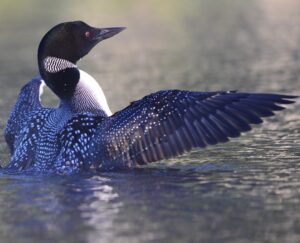
photo by Kittie Wilson
“Fun fact, guess what? if you are worried that you can’t be successful fishing without lead guess again. You already are. My guess is you have used a Mepps or Al’s Goldfish or a tungsten jig. Those are all lead-free because they work better that way. Lead has no special qualities for fishing lures. It is used because it is cheap, available, and easy to craft. Other materials have been used for just as long as lead or longer to add weight to lines and lures,” the “Crappy Hippy” said. How many lead weights have you lost jigging or working the bottom for largemouth with worm weights? Losing tackle is the norm for most of us but like all that ghost gear offshore that rolls along hard bottom, gathering up fish and crustaceans, lost lead is a killer.

no lead to see here…
“Lead-free alloys don’t oxidize like lead does,” John said. “A shiny lead jig head straight from casting will be silver. Within hours it darkens to gray. Swim it in the water and it turns dark gray. You can alloy another severe toxin with lead, antimony, to keep it shiny but we are trying to get away from that sort of thing.” Given their location, many of his lures are designed to catch panfish, crappies, smallies, and largemouth bass but I can see them drawing strikes from local saltwater species as well. John advises that saltwater anglers simply rinse his lures in freshwater after catching a load of bluefish.
Go lead free, catch fish, do no damage
 Their Jester Jigs are perfect for ice fishing, especially considering the many color options they offer, which we know is critical in different winter conditions and lights. I recommend the Custom 4-Pack in a 1/8 ounce #2 Aberdeen pattern. “A slab smacking foursome,” John calls them. That’s hard to beat.
Their Jester Jigs are perfect for ice fishing, especially considering the many color options they offer, which we know is critical in different winter conditions and lights. I recommend the Custom 4-Pack in a 1/8 ounce #2 Aberdeen pattern. “A slab smacking foursome,” John calls them. That’s hard to beat.
You can also purchase packs of bismuth 1/8th ounce grub heads with #1/0 Eagle Claw Aberdeen hooks made for larger plastic tails if you’re looking for monster bass or walleye.
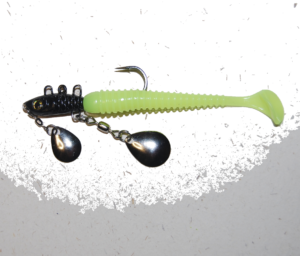
¼ ounce AngleKing with double Indiana blades
“Don’t fear the alternatives to lead, it’s a whole new world of materials and chances to gain an advantage on the fish,” John said. His ¼ ounce AngleKing with double Indiana blades has a clever multi-point tie area that changes angles at various retrieve speeds. The popular Crappie Dueller is smaller, at 1/8 ounce, and can be assembled with a variety of blades, including Colorado, Willow and Indiana then finished with 14 different tail colors and patterns. These include traditional colors like chartreuse and pink glo, along with newer styles of Motor Oil, Avocado, and Dear John. And if you should lose one to a giant bass or head-shaking walleye, you’ll feel better knowing you didn’t poison our waters. Glasswater Angling lures are not yet available in tackle stores in our area so contact them at www.glasswaterangling.com.
Incidentally, John is co-host, along with writer/angler/humorist Tim Bete, of the popular The Lure Love Podcast.
Along with their analytical yet smooth speaking Lure-Matic Computer Lucy, they interview other lure manufacturers and detail histories and fun background stories about a wide variety of lures. Check out this very recent interview with our friends at Al’s Goldfish Lure Company up in the Great State of Maine here. You can tune in on all major podcast platforms or sign up for their newsletter at www.lurelovepodcast.com. How’s that for lead time?
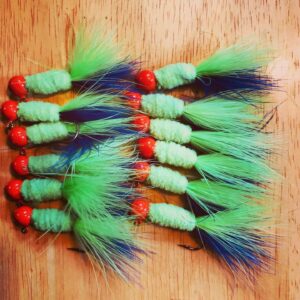
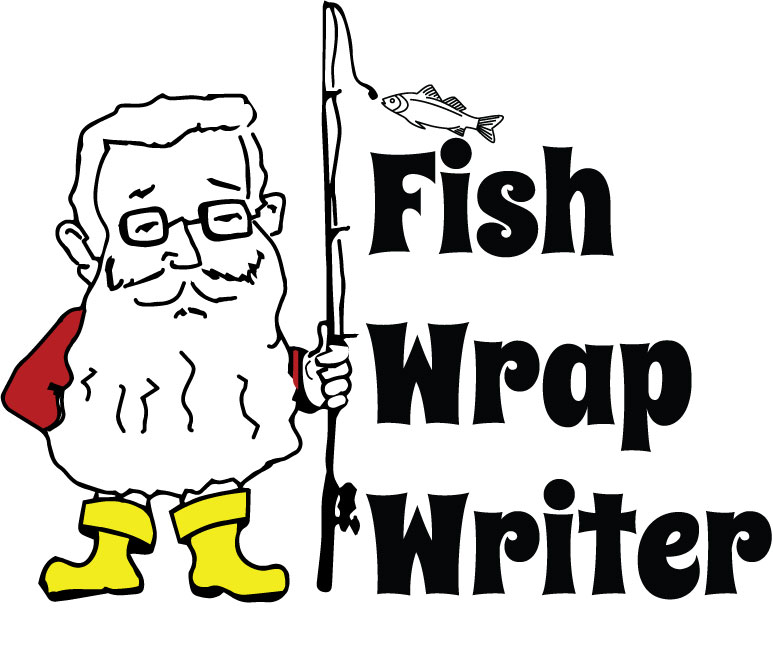

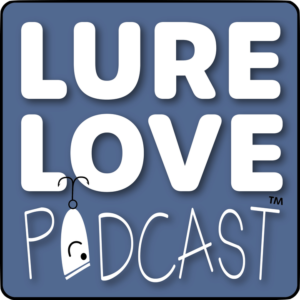

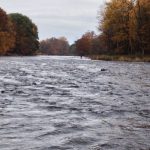
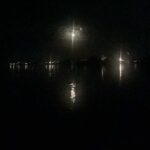

Fantastic!!!! Thank you Todd.
Great article Todd! Three cheers to you, John, and Kathy. I am very grateful to you for spreading the word about lead-free tackle, and to John and Kathy for providing a lead-free alternative to anglers. I am not an expert fisherman, but I’ve fished for more than 45 years. From the technical side, I don’t see the downside of using lead free tackle. It is a bit larger than the lead equivalent. But is that really a problem. Non-toxic bismuth-tin alloys typically weight ~77% that of lead. That means for the same weight, a round bismuth-tin sinker will have only a 9% greater cross section (i.e. diameter) than its lead counterpart. I believe the biggest hurdle to widespread adoption is cost. Though difficult to find, I have found bismuth-tin alloy sinkers for as low as 2.7 times the price of their lead counterparts. Currently, there are many incarnations of tungsten sinkers selling for 5 to 10 times as much as their lead counterparts; and brass sinkers selling for 4 to 6 times as much as their lead counterpart. I hope that through the efforts of individuals like you, John, and Kathy, that more and more anglers determine that lead-free is the way to go. Perhaps then, the economies of scale will bring cost down.
Thanks Steve, you are spot on. Waterfowl hunters switched to tungsten years ago but over time, many come to realize the environmental benefits outweight some small cost increases. John and Kathy are doing yeoman’s work to get us to make the switch. Conservationists continue to make progress and positive changes, perhaps as small as a lead weight to catch a largemouth, with the hopes more people will lean towards protecting our children’s world over just doing what we’ve always done, without considering the consequences. Thank you for reading Steve, I do appreciate it.